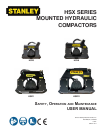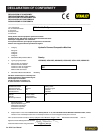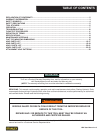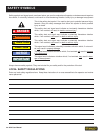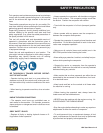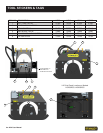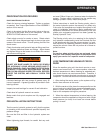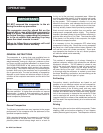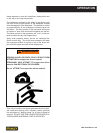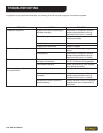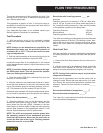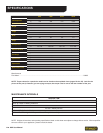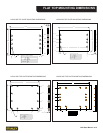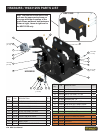
8 ► HSX User Manual
OPERATION
DO NOT suspend the compactor in the air
during the warm-up procedure.
The compactor must be placed at on the
ground with a very slight down pressure to
keep it in place. When ambient temperatures
are below freezing, suspending the compac-
tor in the air without rst warming it up may
cause the shock mounts to crack.
Failure to follow these procedures will void
compactor shock mount warranty.
GENERAL INSTRUCTIONS
The compactor is a device that uses available force to
the best advantage. The DYNAMIC FORCE of the mass
weight assembly, turning at a high rpm, produces a vibra-
tory force, and with controlled placement, an impact force.
The DOWN PRESSURE of the carrier on the compactor
gives a high static pressure which assists in the compac-
tion or driving. The vibration frequency is controlled by the
hydraulic ow input to the compactor and is optimized for
use in granular soils. The rate and density of compaction
depends on such factors as moisture content of the soil,
condition of the compactor and carrier, and the skill of the
operator.
Efcient compactor performance is directly related to the
ow rate specied. A higher ow rate does not improve
performance. It results in uid overheating, and contrib-
utes to early bearing failure. A lower ow rate causes re-
duced compaction performance.
Gereral Compaction
The following instructions are very important to the proper
performance of the compactor and the attainment of the
specied compaction density.
With a standard baseplate, the compactor is held with full
down pressure for no more than 5-10 seconds. The ap-
plication pattern should always begin next to a bank or
footing and at the previously compacted area. When the
maximum attainable density for that particular soil condi-
tion is reached, a slight increase in vibration will be felt
by the operator. This increase in vibration is in no way
harmful to the tractor, and indicates that the soil will not
compress any further. In fact, additional time in that loca-
tion may actually loosen the soil previously compacted.
Work as much area as possible from one position and
overlap each compacted section slightly. The vibration
frequency has been chosen to give maximum efciency in
granular soils using lifts of 2 to 4 feet. The closer the width
of the trench is to the width of the compactor, the higher
the delivered compactive effort.
It is necessary to turn the compactor OFF when being
transported or sitting idle. Should the running compactor
be placed on a hard surface without down pressure, the
unit and the carrier will vibrate excessively. Down pres-
sure transmits the vibration to the soil; neutral pressure
will rattle the whole carrier assembly.
Slope technique
This method of compaction is of primary interest to a
pipeline contractor seeking high production and efcient
equipment utilization. The ll material is placed at one
end of the trench and allowed to seek its own angle of
repose. Compaction is begun on this angle above, but
still near, the top of the pipe. All ll material is backlled
to this angle and the compactor is worked up and down
the slope. Backlling, compaction, and resurfacing can be
done very shortly after the pipe is in place.
Soil testing
Compaction density specications are based on soil
samples of a set moisture content and soil composition.
Changing weather conditions, for example, can alter the
moisture content of the ll being used, and may make
meeting the specications impossible. It is imperative that
frequent and reliable tests be conducted during applica-
tion of the compactor to determine the maximum lift that
can be used and still provide the required density. It is
important that lifts in excess of the established test results
NOT be used if the required density is to be achieved and
maintained.
Driving
Many driving jobs can be done with the compactor. Timber
sheeting, steel and aluminum sheeting, H and I-beams,
soldier piles and guard rail posts. The compactor will drive
IMPORTANT
NOTICE



